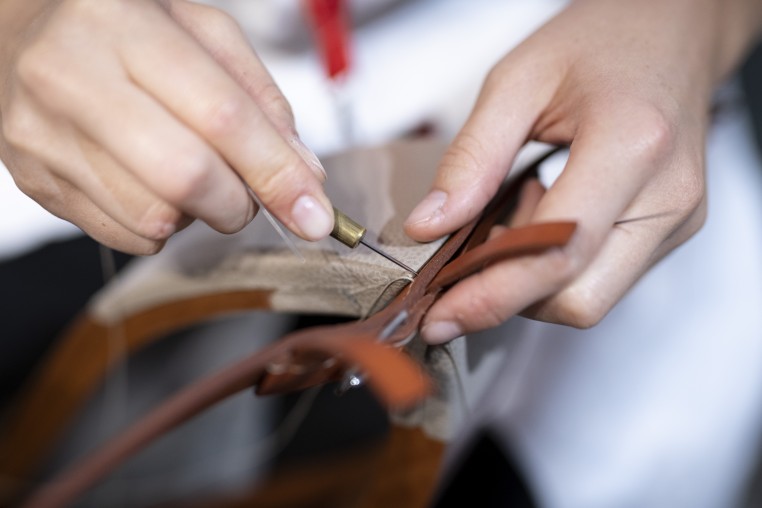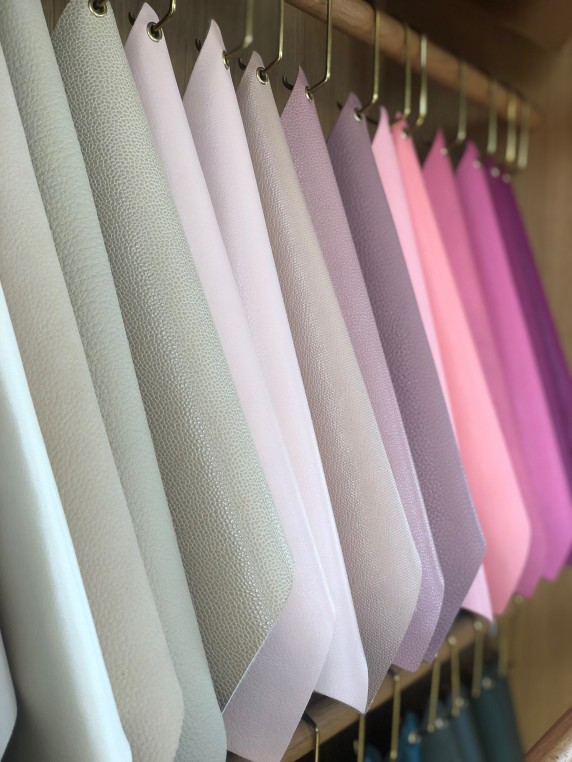En 2018, un tiers des chaussures et 40% des articles de maroquinerie, en valeur, exportés dans le monde proviennent d’Europe. Face aux savoir-faire français, italiens ou espagnols qui caractérisent le luxe, les pays asiatiques maintiennent leurs positions. Cependant, il faut noter la baisse de parts de marché continue du géant asiatique depuis 2010 – la Chine – une situation qui profite au Vietnam. Fait marquant : l’amont de la Filière Française du Cuir qui sort timidement la tête de l’eau dans une situation très compliquée.
Le luxe européen, champion des exportations
Point sur la France et l’Italie, les principaux pays européens sur le podium des exportations
Pour l’année 2018, la France a eu une belle progression dans tous les secteurs de la filière cuir. Les exportations françaises totalisent 5% des exportations mondiales en 2018 contre 4,4% en 2017. Un gain de 0,6 points qui permet à la France de conserver sa 4ème place au niveau des exportations mondiales de la filière cuir, derrière la Chine (33,2%), l’Italie (11,9%) et le Vietnam (11,5%) et sa 5ème place sur le rang mondial en tant qu’exportateur de vêtements et d’accessoires en cuir (5,6% des exportations mondiales) derrière la Chine, l’Italie, l’Inde et le Pakistan. En un an, la France est passée de 11ème à 10ème exportateur mondial de chaussures (soit 2% des exportations), talonnant de près la Belgique, l’Espagne et les Pays-Bas.
Jusqu’en 2010, son voisin italien a eu tendance à perdre du terrain. Depuis 2010, la situation s’est inversée. L’Italie a gagné 2 points de part de marché entre 2010 et 2012. En 2018, l’Italie culmine à la 2ème place au niveau des exportations mondiales tous secteurs confondus et à la 3ème place au niveau des exportations mondiales de chaussures.

La maroquinerie de luxe l’emporte à l’export…
Dans le secteur de la mode, ce sont les accessoires et les articles de maroquinerie notamment qui font la part belle aux marques. Au niveau mondial, la France et l’Italie sont les deux principaux exportateurs européens d’articles de maroquinerie, car positionnés sur le luxe. Les exportations de ces deux pays représentent plus du quart des exportations mondiales. En valeur, 58% des articles de maroquinerie exportés dans le monde viennent d’Asie, contre 40% venant d’Europe. Ces 40% se répartissent entre les ventes à l’intérieur de l’Europe (19% des exportations mondiales), les ventes en Asie (17%) et les ventes sur le continent Américain (4%). La France conserve donc sa position de 3ème exportateur mondial d’articles de maroquinerie (représentant 11,5% des exportations mondiales) grâce à son positionnement haut de gamme, derrière l’Italie (14,8%). Son savoir-faire – cousu-sellier – très prisé par les maisons de luxe, et les demandes en sac à main en constante progression ont entrainé l’ouverture de nouveaux ateliers, soient 3 000 emplois à pourvoir chaque année, dont 1 000 créations de postes.
… mais le marché intérieur européen préfère le moyen gamme
De manière générale, l’Europe exporte notamment des articles de maroquinerie de luxe mais consomme du moyenne gamme d’où ses importations provenant pour moitié de l’Asie.
Face à la baisse de la Chine, l’ascension du Vietnam et l’entrée de l’Indonésie
Le géant asiatique affaibli
Bien que la Chine demeure le premier exportateur mondial, sa perte d’influence se confirme d’année en année (33% des exportations mondiales en 2018 contre 45% en 2010). En 8 ans, elle a perdu 12 points de parts de marché. La chute est plus marquante dans le secteur de la maroquinerie. Les exportations chinoises d’articles de maroquinerie représentaient 58% en 2010 contre 41% en 2018. Le secteur de la chaussure subit la même tendance, passant de 50% des exportations mondiales à 35%.
D’autres pays émergents gagnent du terrain…
Sur l’année 2018, c’est le Vietnam qui connait la progression la plus marquée. Ses exportations représentaient 2,7% des exportations mondiales en 2000, contre 5,4% en 2010 et 11,5% en 2018. Le déclin de la Chine a profité au Vietnam, qui a tiré son épingle du jeu, notamment sur le marché de la chaussure, et fait émerger des pays comme l’Indonésie. Ces deux pays ont gagné du terrain ces dernières années - et dominent le marché à : 16,8% des exportations mondiales de chaussures pour le Vietnam, le plaçant à la 2ème position (suivi par l’Italie à 9% en 2018). L’Indonésie représente 5,3% des exportations en 2018 et se retrouve à la 4ème place. Pour le secteur de la maroquinerie, le Vietnam se positionne en 4ème position (5,7% des exportations mondiales d’articles de maroquinerie) derrière la Chine (40,8%), l’Italie (14,8%) et la France (11,5%). Seule l’Inde, qui jusqu’ici avait connu une longue période de croissance avec un pic en 2014, perd du terrain ces dernières années pour l’ensemble de la filière cuir (- 0,4 point depuis 2015).
… pour répondre à une demande occidentale de produits accessibles
Les produits provenant d’Asie répondent à une demande mondiale où la mode prime sur l’usage du produit. L’Allemagne, l’Italie et la France sont respectivement les deuxième, troisième et quatrième importateurs mondiaux pour la filière cuir, derrière les Etats-Unis. Les importations de ces trois pays représentent 19,3% des importations mondiales (contre 18,3% en 2015). La part des importations françaises est quant à elle passée de 5,4% en 2015 à 5,8% en 2018. Seuls les USA font exception à cette tendance. Sur la même période la part des importations des Etats-Unis est passée de 20,1% en 2015 à 17,2% en 2018. Ce ralentissement de la demande américaine affecte plus l’Asie que l’Europe. Les exportations de l’Asie vers les USA représentent 19% des échanges mondiaux, contre 3% pour les exportations de l’Europe vers les Etats Unis.
Aujourd’hui, on assiste à un changement des modes de consommation, le client se dirigeant vers des produits plus éthiques, durables ou privilégiant une économie de fonctionnalité qui consiste à louer des produits ou utiliser des produits de seconde main. Il est à envisager que ces profondes mutations entraînent une redistribution des cartes à l’avenir.
La France en légère progression sur le marché des matières premières à l’international
Malgré une forte baisse de la demande mondiale en peaux d’ovins, la France conserve sa place sur le podium des exportations des cuirs et peaux bruts
Les ventes européennes de cuirs et peaux bruts représentent 45% des exportations mondiales : 38% pour les ventes à l’intérieur de l’Europe et 7% pour les exportations de l’Europe vers l’Asie. La moitié des cuirs et peaux bruts exportés dans le monde est achetée par la Chine ou l’Italie (respectivement 29,9% et 20,4% des importations mondiales). Grâce à son cheptel, la France est toujours le 3ème exportateur mondial de cuirs et peaux bruts derrières les Etats-Unis et l’Australie. En valeur, 7,1% des cuirs et peaux bruts exportés en 2018 dans le monde viennent de France, contre 6% l’année précédente. Cette progression est liée au recul des Etats-Unis et de l’Australie qui perdent respectivement 1,6 et 0,3 points de marché.
La tannerie-mégisserie peine à décoller à l’export mais fournit le marché local
Dans ce secteur, l’Italie connait une forte progression. Ses parts de marché sont passées de 20,1% en 2015 à 22,4% en 2018. En tannerie mégisserie, l’Italie est le premier exportateur mondial devant le Brésil (9,9% des exportations mondiales), les Etats-Unis (4,8%) et l’Inde (4,7%).
En tannerie mégisserie, la France se positionne en 14ème position dans le palmarès des principaux exportateurs mondiaux. Elle gagne 0,2 point de part de marché. En valeur, 2% des cuirs finis exportés dans le monde viennent de France. Les principaux clients de la France sont l’Italie (36%), la Tunisie (8%), l’Espagne (8%), pays renommés pour la fabrication de produits finis, sans oublier le marché local où les maisons de luxe ont investi dans les tanneries françaises.

Frank Boehly, Président du Conseil National du Cuir : « Nous nous réjouissons que la France demeure un acteur majeur dans le paysage des industries créatives. Il est important de rappeler qu’elle a su conserver sa 4ème position mondiale, car notre pays s’appuie sur des savoir-faire d’excellence portés par des artisans passionnés, sur des jeunes créateurs motivés avec une démarche responsable et innovante et surtout sur son positionnement haut de gamme qui est synonyme de qualité… la French Touch ! »
Téléchargez la brochure des Echanges Mondiaux de la Filière Cuir basés sur l’année 2018*.
* Les données des échanges mondiaux sont disponibles avec presqu'un an de décalage, le temps d'obtenir les statistiques de l'ensemble des pays.
---
Le Conseil National du Cuir, avec son Observatoire Économique, répond à sa mission d’information auprès de tous les acteurs de la Filière Française du Cuir. Ainsi, tout au long de l’année sont réalisées : une brochure et des fiches pays sur les échanges mondiaux de la filière cuir, une étude sur le Commerce Extérieur de la France, des enquêtes annuelles de conjoncture par secteur d’activité (Cuirs et peaux bruts, Tannerie-Mégisserie, Chaussures et Maroquinerie), des notes mensuelles de conjoncture sur l’activité globale des entreprises françaises de la filière industrielle du cuir et sur leurs échanges extérieurs, des fiches sur l’activité annuelle de la Tannerie-Mégisserie, de la Chaussure et de la Maroquinerie, ainsi que des études dans le secteur du commerce.
Toutes ces données sont publiées sur le site www.conseilnationalducuir.org

